Nottingham Forest
Nottingham Forest emerged from a group of "shinty" players (a form of field hockey) who resolved at a meeting in the Clinton Arms to adopt association football. Their first game was played against Notts County (formed three years earlier) in March 1866. In those very early days, teams did not play in kits as we understand it: players would turn out in whatever they had to hand and teams would be distinguished by wearing distinctive scarves and/or caps. Forest ordered a dozen red caps "with tassels." The committee resolved that the clubs official colours would be "Garibaldi Red" after the Italian patriot whose party was known as the "Redshirts." This is a somewhat darker shade of red than is in widespread use today. Forest are credited with a number of innovations: they were the first team to adopt shin guards (1874) and to provide the referee with a whistle (1878). The club are also believed to have invented the classic 2-3-5 formation that persisted into the 1960s.
The team's unusual name derives from their original home, the Forest Recreation Ground (which itself was named for Sherwood Forest).
Forest refused an invitation to join the Football League in 1888 fearing that the FA would punish those that joined. Their fears proved groundless and a year later, Forest joined the rival Football Alliance instead. In 1892, the Alliance was incorporated into the Football League as Division Two. Forest, having won the Alliance championship were elected directly into Division One. In 1898 Forest won the English FA Cup, equalling the achievement of arch rivals Notts County who had won it four years earlier. Relegated in 1906, Forest immediately won promotion as champions of Division Two only to drop back down in 1911. In 1914 the club finished bottom and were forced to seek re-election in a season that saw Notts County promoted as Division Two champions. In 1915 the club almost went out of existence but they survived when the League was suspended and the club was relieved of the burden of paying players' wages.
In 1922 Forest won the Second Division championship but struggled to survive in the First Division, finally being relegated in 1925. By the late 1930s, Forest were struggling to stave of relegation to the regional leagues. Once again facing a financial crisis, the club was kept afloat by committee members digging into their own pockets. Although it is difficult to be certain, given the problems of interpreting old monochrome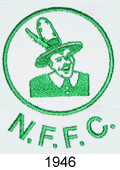 photographs, it appears that Forest continued to wear dark red shirts at least until the late 1920s.
photographs, it appears that Forest continued to wear dark red shirts at least until the late 1920s.
After the Second World War the club's crest sometimes appeared on the team shirts: this consisted of the arms of the city of Nottingham with the club's initial superimposed. This became a permanent feature in the 1958-59 season.
When the League resumed after World War Two, Forest struggled and in 1949 they were relegated to Division Three (North). Four years later they won promotion back to Division Two followed by a return to the First Division in 1957. In 1959, Forest beat Luton Town in the FA Cup final to win their first major trophy of the twentieth century. The 1966-67 season brought the club tantalisingly close to the double, finishing runners-up in Division One and losing in the semi-finals of the FA Cup.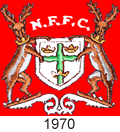
The club crest was slightly modified in 1970 so that it could be embroidered directly onto the shirt rather than appearing out of a white patch, a style now considered old fashioned. In 1972, Forest were relegated back into Division Two and seemed to be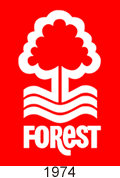 destined to continue to their career as chronic underachievers.
destined to continue to their career as chronic underachievers.
Around March 1974 the old club crest was replaced by a modern design above the word "Forest." This iconic design became associated with the transformation of the club under Brian Clough, who arrived on 6 January 1975.
With a side built around players from his championship Derby County team and bolstered by his old colleague, Peter Taylor, Clough built a series of sides that would transform Forest into Europe's premier club. Bearing in mind Forest's meagre record to date, Clough's achievements are remarkable: Division One Champions in 1978, League Cup Winners in 1978, 1979, 1989, 1990, the only domestic trophy Clough failed to win was the FA Cup. In Europe, however, his sides were superlative and Nottingham Forest were crowned European champions in 1979 and 1980. By 1993 Clough's regime was running out of steam. With relegation inevitable, an FA investigation into illicit transfer "bungs" pending and allegations about his private live reverberating in the tabloid press, Clough retired amid tearful scenes.
Clough's place was taken by ex-player, Frank Clark, who took Forest back into the Premier Division in 1994 and third place the year after. In 1997, Forest were relegated, were Nationwide Division One champions the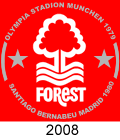 following season only to be relegated again
following season only to be relegated again 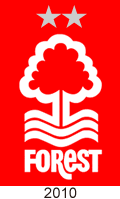 in 1999. On 20 September 2004, Clough died and the club that he had transformed into European champions were relegated to League One, the equivalent of the old Third Division. The club languished here until 2008 when they managed to win automatic promotion to the second level.
in 1999. On 20 September 2004, Clough died and the club that he had transformed into European champions were relegated to League One, the equivalent of the old Third Division. The club languished here until 2008 when they managed to win automatic promotion to the second level.
To mark the twentieth anniversary of their European Cup triumphs, Forest's crest was enhanced with silver embroidery for the 2008-09 and 2009-10 seasons. The two silver stars were retained when the traditional version reappeared for the 2010-11 season.
